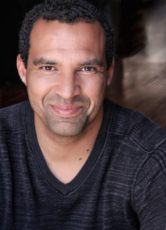
Picture yourself preparing for a self tape audition, getting ready to perform a monologue for your acting class, stepping up to the mic for a voice acting gig or singing in front of a large audience. What is the first thing you do? Do you dive right into the material and start cold? Or, do you take time to focus, preparing your breath, voice, body and mind for the performance you are about to give?
If you answered with the latter, you’re ahead of the game. Physical and vocal warm-ups are key to an actor’s success. A proper warm-up can help you relax, feel your breath, be in the moment, find your vocal placement, improve your vocal health and even help with character development. Best of all, physical and vocal warm-ups are a no-cost option to build your skills, meaning actors can perform them even on a tight budget.
When working with clients, I focus on five areas of a vocal warm-up: body, breath, phonation, articulation and intent. Addressing these areas prepares us for what comes next, whether it is an audition, rehearsal or performance.
In this article, we’ll discuss why physical and vocal warm-ups are essential and provide examples of effective vocal warm-up exercises you can add to your daily routine to enhance your performance and land your next gig.
The Role of Physical Warm-Ups
Acting, singing and even public speaking are full-body activities. Even when standing still, your body plays a large part in breath management and vocal projection. Tension in the body can create tension in the voice. Physical warm-ups help you loosen up your body, preparing you to focus on breath and phonation.
Here are some examples of physical warm-ups to add to your daily routine. Please note that all exercises start with a neutral standing position: feet shoulder-width apart, aligned with your hips, knees slightly bent, back straight, relaxed shoulders, and head facing forward.
- Bend down at the waist as if you are about to touch your toes and let yourself feel loose. Let your arms hang. Sway slightly from side to side, allowing your swaying to guide your body back and forth gently. Now, while still bent, come back to center and slowly roll up, one vertebra at a time, to your neutral position.
- Gently roll your shoulders backward a few times and then roll them forward a few times.
- Bring your left hand across your body and gently rest it on your hip. Raise your right hand above your head and stretch toward your left side until you feel a nice stretch going down the right side of your body, and then return to your neutral standing position. Repeat on the other side.
- Shake out your hands and legs.
- Return to your neutral position. Place your head on one shoulder and gently roll it to the other to loosen up your neck.
Breathing Exercises
Connection to the breath is the connection to the voice. The breath is critical for vocal projection and placement. Often, we breathe differently in everyday life and normal conversation than we do while acting or singing.
When acting and singing, a low breath is necessary. You may have heard directors or vocal coaches say, “Breathe from your diaphragm!” They are asking for diaphragmatic breathing, also known as belly breathing.
In everyday life, breath is likely shallower, and we do not necessarily pay attention to how much breath we need in everyday conversation as we do when we are performing text.
It is therefore important to learn proper breath management and actively connect to the breath through warm-ups before auditions, rehearsals and performances.
Let’s look at a few simple breathing exercises to add to your vocal warm-up routine. Breathe through your mouth for all of these exercises:
- Lay on the ground and place a heavy book on your stomach. Breathe in and out and feel the book moving up and down as you breathe. This is low, diaphragmatic breathing. Make a note of this feeling and stand up in your neutral standing position. Now, put your hand on your stomach and take a few breaths, feeling your stomach go out and in as you breathe.
- Take a low breath over four counts and pretend you are blowing through a straw while you exhale. See how long you can breathe out with a consistent flow before running out of breath. Can you extend this amount of time over several vocal warm-up sessions?
- Hold your index finger a few inches in front of your mouth and pretend it is a candle. Breathe in and then rapidly exhale five times, as if blowing out five candles, without taking breaths between the five exhalations.
The Importance of Vocal Warm-Ups
Your voice is your instrument. It may sound corny, but it is true. Like musicians use their instruments, actors use their voices to convey meaning through tone, volume, articulation, tempo and pitch. A proper physical and vocal warm-up ensures that you are readying yourself to convey those meanings without strain or stress.
I like to break the vocalization part of the warm-up into three categories: phonation, articulation and intent. Phonation involves making sounds and exploring range. Articulation is creating spoken words or word-like sounds with a focus on clarity. Intent involves using warm-up exercises and techniques to address a specific concern.
Here are some voice warm-ups for actors that you can add to your daily practice:
Phonation:
- After completing the breath warm-up, take a low, relaxed breath and then let out an audible sigh, gliding from your highest comfortable pitch to your lowest comfortable pitch. Repeat this a few times.
- On a hum, sing from the 5th note of the major scale stepwise down to the 1st note of the scale. Repeat this exercise several times, starting a half pitch higher each time and working through your range. Remember to stop if anything feels strained or painful.
- Make siren sounds (woo, woo, woo!) in the high part of your range.
- Vocalize lip trills (blowing air through your lips so they move quickly together). Start at the lowest comfortable area in your range where you can create a trill, slide slowly up to the highest comfortable spot, and back down again. This will likely tickle quite a bit, so working through your range may take some time. Lip trills are the most effective vocal warm-ups, simultaneously addressing breathing, body and voice. Lip trills are the go-to exercise if you cannot do a complete warm-up.
Articulation:
- Do a short physical warm-up for your face. Massage your face and jaw, wiggle your jaw, stretch your tongue and do lip and tongue trills.
- Use unvoiced syllables like “tuh,” “puh,” “buh” and “kuh” to create patterns:
tuh, tuh, tuh
buh, buh, buh
puh, puh, puh
kuh, kuh, kuh
tuh buh, tuh buh, tuh buh
tuh buh kuh, tuh buh kuh, tuh buh kuh
And so on. Practice these patterns at different speeds, ensuring all consonant sounds are clear. - Repeat the above exercises with voiced syllables, such as “tah,” “bah” and “tee.”
- Tongue twisters are great for working articulation. Find a few of your favorite tongue twisters and use them as exercises for articulation, paying attention to the clarity of your speech as you speak them. Work the tongue twisters at different speeds, going slowly and over-enunciating, then speeding up. (If you need help finding tongue twisters, the College of William and Mary has a helpful one-sheet list).
Intent:
Exercises for intent will vary based on your needs, depending on the day and role. Here are some examples of intent exercises:
- An actor runs out of air before the end of the most important phrase in their monologue. During the warm-up, the actor practices the phrase on a lip trill, using the exact characterization and inflection they would use on stage, but without words. When the actor can get through the phrase on the lip trill, they start earlier in the monologue on a lip trill, taking breaths where they would typically breathe. Once the actor can get to and through that phrase on the lip trill, they immediately rehearse that part of the monologue with words, applying what they felt while trilling to speech.
- An actor has a line that needs to be spoken quickly, but is losing some clarity due to the speed. They bring this line into their warm-up and work with it as they would work with a tongue twister. First, they slow down the line and over-enunciate to practice making the sounds. As the actor practices, they speed up the line while continuing to over-enunciate. Eventually, the actor speaks the line at double the speed they use for performance, still over-enunciating. As this becomes more and more comfortable, the actor begins to speak the line at performance speed and eases off the over-enunciation until they find the right mix for clarity and speed.
Consistency and Personalization in Warm-Up Routines
Warm-ups not only help you prepare for the immediate moment, but they can also help you build healthy habits and skills when done over time. Rome wasn’t built in a day, and your vocal technique won’t be either. It is therefore imperative to be consistent in your warm-ups, making them a part of your daily practice.
What works for one person may not work for another, meaning it may take time to find the warm-ups that work for you. Over time, you will likely work with coaches and directors who will help you through vocal warm-up exercises, and you will learn some from your peers and colleagues as you rehearse together. With time, you will know which exercises help you and create a warm-up routine that works for you.
Based on your circumstances, you may need to switch up your warm-ups. For example, you may need different phonation and articulation exercises to find the proper placement and cadence when working with a dialect. It is okay to experiment, as long as you do not feel any tension or pain.
There is no set time limit for how long a vocal warm-up should be. I aim for about 20-30 minutes. However, the length of warm-up you need can vary depending on the situation. If you have just woken up and need to get ready for an audition, you may need 30-45 minutes. If you have been speaking or moving most of the day, you may need only 15 minutes. As you get to know your body and voice, you will learn what works for you and gauge the length of your warm-up accordingly.
Remember, the best vocal warm-up is one that you will actually do. If you don’t have time one day to do your full warm-up, choose some exercises you know will help you relax, connect to your breath, and find your vocal placement.
Preparing for an Audition
When preparing for an audition, it is easy and necessary to focus on preparing sides, reading the script (if available) and doing relevant research into the role. However, it is also important to remember to prepare your voice for an audition.
The first step to preparing your voice for an audition is to focus on vocal health. Hydration and avoiding vocal strain (which can be caused by yelling, whispering, stress, lack of sleep, etc.) are great ways to start. Focus on drinking water and avoiding dairy, alcohol or caffeine immediately before the audition.
Then, go through your warm-up routine, focusing on body, breath, phonation and articulation. If your audition is in person, you may need to do your warm-up elsewhere. If you are waiting between your warm-up and your audition, focus on breathing and doing lip trills while you wait. The key is to try to keep yourself relaxed.
Wrapping it all up:
- Physical and vocal warm-ups help you to relax, feel your breath, be in the moment and find your vocal placement.
Warming up can help improve your vocal health. - Physical warm-ups are essential because the body plays a large part in breath management and vocal projection.
- Breathing exercises help us learn proper breath management and help us connect to the breath as we prepare for vocalization.
- A proper vocal warm-up helps an actor convey meaning through tone, volume, articulation, tempo and pitch without strain or stress.
- Warm-ups help you prepare for the immediate moment while also helping you develop healthy habits and skills over time.
- The best vocal warm-up is the one you will actually do.
Physical and vocal warm-ups are essential for actors and singers. Finding exercises that work for you and incorporating them into your daily practice will help you improve your breath management, vocal placement, vocal health and overall performance. Remember—a proper warm-up is a no-cost, budget-friendly way to build your skills. So, before your next audition or performance, take some time to prepare your mind, body, breath and voice, and give yourself the best chance to succeed.
Now that you’re warmed up and ready to work, sign up for Casting Frontier and find your next audition!
You may also like:
- The Power of Voice and Speech Training
- The Importance of Learning Voice Projection Articulation and Diction
- Tips to Enter a Scene Powerfully
Written by Shannon O'Neill




